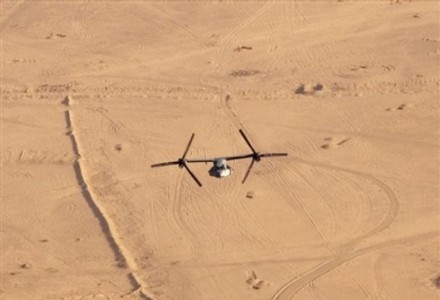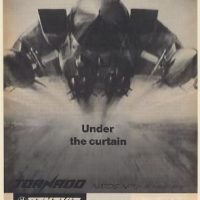This article first appeared in The eXile on February 21, 2008.
FRESNO, CA — OK, let’s talk hardware for once. I love the hardware, always have; the reason I don’t talk much about it is that what we’ve got is mostly useless, and what we really do need is always getting slammed. I’ll give you two examples: the F/A-18 and the V-22.

If you’re a typical half-baked Tom Clancy fan, you know what to think of both these planes: F/A-18 good, V-22 bad. Wrong on both counts. In fact, that’s why it’s hard to talk hardware, because you have to de-program so much crap from the standard view.
Start with the V-22 Osprey. You probably know the basics: it’s a transport aircraft with engines out on the end of the wings that can rotate forward to fly like a conventional plane and tilt up to vertical (that’s what the V is for) so it can land like a helicopter.

Rotating propellars: The ultimate insurgent cuisinart!
And everybody knows, or thinks they know, that it’s a lemon. It’s ten years behind schedule; it keeps crashing; it’s already killed more than 50 Marines. And Dick Cheney hates it. Back when he was Secretary of Defense, Cheney said the V-22 was “…one weapons system I don’t need.”
That’s as good a place as any to start your deprogramming: whatever Dick Cheney says, think the opposite. If Dick Cheney tells you it’s a sunny day, get your umbrella. It’s no surprise to me that Cheney hates this weapons system, because Cheney is, and I’m kind of half serious here, an Iranian agent who hates America and wants to destroy us. He’s all for spending trillions of our tax dollars on absolutely worthless weapons like aircraft carriers, but he fought hard against the Osprey because it’s the one contemporary weapons system that could have made a difference in Operation Desert One/Eagle Claw, the Iran hostage-rescue attempt back in the days of Reverend Jimmy Carter.
That’s a good handy test to ask yourself about any weapons system: would it have helped in Desert One? That’s the kind of mission we need to think about : special ops, fast and quiet.
So, would the Osprey have helped? Hell yes. If we’d had something like it in service, the rescue mission might not have ended so disgustingly. You probably remember the whole miserable story back in 1980: we had to use CH-53 heavy-lift choppers on that raid, even though they’ve always had a bad rep, and they’re not designed for transport anyway, let alone high-value, high-risk special operations transport. By the time they reached their first rendezvous with the USAF’s C-130. Only five of the eight choppers were still working, and the mission was scrubbed. During takeoff after the scrub, one of the CH-53s, underpowered and overweight, was blown into a C-130. Kaboom! Giant fireball, eight men dead, and the next day some greasy mullah had himself photographed holding up a charred American pilot’s arm. If you’re a glutton for pain, you can read the more detailed article I did on it.
Replay that raid with the Osprey as basic transport and you get a very different result. The Osprey carries 32 troops at a cruising speed of 250 mph; there’d be no need to land in the middle of the desert, because it can be refueled air-to-air. The flight would have landed directly at the staging area near Tehran, without any need to touch down in the desert during a sandstorm. A fleet of Ospreys instead of CH-53s would probably have ferried Beckwith’s guys safely to their staging base outside Tehran.
To be honest, I don’t think the mission, at least from that point on, ever had a chance; it was James Bond crap that required this big American force to infiltrate Tehran in trucks and rescue the hostages, then fight its way back to the planes. It was like some mid- 80s screenplay that would’ve starred Patrick Swayze.
Nobody would have made it home alive, but at least they would have died killing Revolutionary Guards at a nice, satisfying 20:1 ratio, with our air cover turning Tehran into a toasty lesson on why you should be nice to American diplomats. There’s failure and there’s failure, and with better transport this could’ve been a glorious failure instead of a painful (really painful, I remember!) joke.
Suppose the Osprey really isn’t a very safe aircraft. That’s the knock on it, after all. Well, the hard answer here is, so what? It’s a revolutionary advance in exactly the kind of war we actually need to learn how to fight. If that costs a few lives along the way, so be it. The question nobody bothers asking is whether the lives lost on a particular aircraft are worth it or not. So if you have, say, an unsafe carrier-based fighter, then to me that clunker’s not worth one American life, because it’s useless. Its whole existence is a waste of lives and money. But if you have a VTOL special ops transport that gets your guys in and out twice as fast, with no clumsy refueling stops, then it’s worth the lives spent to learn how to make it mechanically reliable. God knows we’ve lost a lot more guys in less worthwhile ways.
Try thinking like the enemy. Would Al Qaeda hesitate if it had a flight of Ospreys that could land near Capitol Hill, even if their head maintenance guys told them that, say, one-third of the planes were going to crash before they got to the target? Nope. If the mission is that important, and the Osprey is designed for exactly the most important missions we’ve got, then you can live with losses.
Besides, I’m not convinced the Osprey’s really that unreliable. There have only been four major crashes, and for such a revolutionary design that’s not bad. Compare that to the really scary record of the F-18 variants we sold to the Aussies: four of the 71 they bought have crashed already, but nobody’s panicking about that.
So why does the Osprey get so much bad-mouthing?

The F-18 after colliding with a bird: “Yeah, but
you shoulda seen what that seagull looks like!”
Before you let me answer for you, let’s give you a lesson in thinking hard about hardware. You tell me, why would the Air Force, the Navy and the Army hate a weapons system like this one? Remember, we’re talking about jealous branches of the Armed Services, we’re talking about billions of dollars, we’re talking about a world where an Air Force general takes off his uniform and gets a lobbying job without even blinking. And keep in mind that each one of the Armed Services will do anything to keep from losing money to the others.
I bet you got it by now. The Osprey is a Marine Corps project. This should be the last clue you need: what makes the Corps different from all the other services? Answer: because it has its own air wing, and this USMC air wing is the only American force that’s allowed to operate fixed-wing aircraft, helicopters, or mutants like the V-22; all the other services have to stick to one or the other kind of aircraft. The Army is limited by law to helicopters and the Air Force has a monopoly of fixed (or swept-) wing craft. So a plane like the Osprey, that can turn from one to the other in a few seconds, is about as welcome as a sneezing duck on a trans-Pacific flight from Hong Kong.
Defense appropriations are an annual turf war between the services, and the Osprey doesn’t even have any identifiable turf. It’s a bird, it’s a plane, it’s a procurement officer’s worst nightmare! It threatens the whole paranoid truce between the three big services about who owns what.
The fact that the V-22 might actually help us fight irregular wars like the ones we actually need to plan for doesn’t figure at all. They’d laugh at you if you brought that up. It’d just prove that “you don’t get it.” To them, this is like an advertising campaign. They want to sell programs to Congress so they can buy another condo in Costa Rica.

Congressman plays with an F18 model before voting.
I’ve actually read proud stories of big sales by lobbyists. They actually brag about robbing us. They sold the F-22 Raptor by dazzling Congress with all this Knightrider dashboard crap. The reason they had to switch sales pitches is because they were having a problem using their old approach: the Soviet threat.
Somebody asked the annoying question, “Uh…what Soviets? Didn’t they kinda go outta business?” So the lobbyists actually ran a campaign called “Save the Raptor”—like it was some Sierra Club bird watcher’s PBS documentary call-in show. And, wouldn’t you know it, they saved the Raptor! Nobody knows what the Raptor’s good for, unless all our F-15 squadrons suddenly come under the control of the Hypno-toad and have to be knocked out of the sky by an “even more advanced!” fighter.
They won, the sales pitch worked. Maybe they can even come up with a civilian version of the Raptor, sell one to Ah-nold at a discount, make a killing with the street-racer crowd. It’d probably be pretty good at that. But it sure isn’t any use in a war like Iraq or any other war we’re going to be fighting on this planet.
But don’t expect Cheney or any of his pals to say so. The only weapons systems they hate are the ones like the Osprey, hardware that actually might help us fight and win irregular wars.
In case this sounds harsh, let’s talk about another weapons system, one that Tom Clancy just loves, the f ucking moron: the F/A-18 Hornet. I happen to know everything there is to know about how this clunker came into service, because my baptism of fire as a hardware war nerd was the Lightweight Fighter Program, the big showdown between two contenders for a smaller, cheaper fighter to complement the F-15. I was still in grade school, and a lot of the technical stuff was over my head, but by reading everything the library had, every issue of Armed Forces Journal and Aviation Week, I got the main line of the story.
The idea behind the Lightweight Fighter was that, in an all-out air war against the Warsaw Pact, we’d lose a lot of planes, so we needed a HiLo mix of expensive high-altitude air-superiority fighters like the F-15 and F-14 and cheaper, lighter planes that could match the dogfighting agility of the MiG-21. We were overrating the MiG-21, as it turned out, but at the time everybody took it real seriously. Why not? There was no money in admitting the MiG-21 was a flying Yugo. Totally inferior to the earlier MiG designs. It was supposed to be a lean, mean killer and we needed something to match.
Of course the F-4 Phantom was part of the problem. It was lousy in dogfights over North Vietnam, because it handled like a SCUD, an interceptor pushed into duty as a dogfighter. The USAF had been pushed into accepting the F-4, a Navy carrier-based design, and hated it. One outcome was the Top Gun schools to re-train pilots to stick and move; the other was the Lightweight Fighter Program, which was supposed to give them a fighter that could play bumper-cars instead of just drag racing.
There were five entries, but it soon came down to two contenders: the General Dynamics YF-16 and the Northrop YF-17. Both services, the USAF and the Navy, had agreed to buy the winning design. And it was pretty clear, even to a naive kid like me, that General Dynamics was the winning team this time. I knew how to read between the lines from being a big Oakland Raiders fan: I knew what the writers were saying in that careful language they used. And they were saying Northrop’s design was a dog, but GD’s was amazing.
Nobody much liked GD back then, because the F-111 fighter-bomber had a bad rep, but their F-16 prototype outflew the Northrop contender every time. It was more mobile at high speed, and it even cost less: $4.6 million per copy, vs. $5 million for the Northrop. In 1975 it was officially announced as the winner. And that’s when things got weird. At the time I just didn’t understand what happened. Too young and dumb, too trusting–like most war nerds are even today.
First big shock was that the Navy went back on the deal, announced it wouldn’t buy the F-16 and was going to adopt a modified version of the F-17. The official reason was that the F-16 had only one engine, and the Navy had always had double-engine fighters. The Northrop design, the YF-17, was a twin-engine.
But that two-engine story was actually a lie that the Navy figured was simple enough for Congress to understand. I remember hearing the same story from my uncle, who dived for abalone on weekends in this crappy old boat with double inboards. My dad would just nod while my uncle went on about how you had to have two engines, one just wasn’t safe…and then when we were back in the car heading home, my dad would explain that was a lot of nonsense that dated from the days when marine engines were so hopeless you had to have a spare if you wanted to stay off the rocks. Any decent modern diesel would do you fine.
And when you consider that the F-16’s engine was none other than the Pratt & Whitney F-100, the same beautiful machine that powered the F-15, the double-engine story sounds pretty feeble. The F/A-18’s GE F-404 never had, and never will have, the same legendary rep as the P&W F-100. In fact, they had to do endless modifications just to get the thing to work.
The real reason the Navy didn’t want the F-16 was that the USAF was going to be using it. Even though they’d stuck the USAF with the F-4, they weren’t going to take their promised turn making the big adjustment. The Navy didn’t really think much of the Northrop YF-17, but they liked the fact that it would be all theirs.
And to show that they were calling the shots, the Navy went and did the ultimate betrayal: they bought the Northrop design, and then froze Northrop itself out of the development process, the whole long, profitable business of converting the YF-17 into a carrier-based airplane that eventually became the F/A-18. They handed over the whole program to a contractor they liked better, McDonnell Douglas.
The reason the Navy wouldn’t let Northrop handle the program goes all the way back to the 1940s, when these companies were still run by the guys they’re named after. Northrop was the property of John Knudsen Northrop, who had earned the total, eternal hate of the Navy by daring to tell Congress that we didn’t need aircraft carriers any more. That’s the one thing you don’t ever tell the Navy, even though everybody knows it’s true. Northrop was just trying to sell his weird “flying wing” designs when he made that crack about the carriers, but the damage was done. Thirty years later, the Navy brass got its revenge by taking Northrop’s F-17 away and making it the McDonnell Douglas F/A-18.
It wasn’t a very good design then, and it isn’t now. The F-16 has had a totally brilliant career, proved itself in air superiority and ground attack versions. The F/A-18 clunks along thanks to great pilots and a lot of cash, but it’s just not that great an airframe.
The only reason the F/A-18 exists is to be put on aircraft carriers. Which brings us back to what Jack Northrop said more than fifty years ago: why do we need aircraft carriers?
If you look hard at the Navy’s weird little dance after the Lightweight Fighter Program, what you see is a mediocre plane that never should have been funded, sitting on the decks of the most expensive, useless and vulnerable warships ever built.
When we scrambled F/A-18s to intercept old Soviet Tu-95s that were photographing the USS Nimitz in the Pacific last week (Feb. 11), the whole farce got me down. Here’s a couple of rusty, slow, hopelessly obsolete 55-year-old Soviet bombers pretending to threaten a US aircraft carrier that’s just as obsolete as they are. Every ham actor in that little drama should have retired long ago; it was like watching a fight between a couple of old heavyweights who should be enjoying their golden years in a wheelchair but keep getting trotted out because Don King knows how gullible we all are.
The Russians can get better pictures from their satellites than the poor old Tu-95s got; the Nimitz is a worthless target anyway, designed to fight WW II; and the F-18 that intercepted it only exists because the Navy turned down a superior plane, the F-16, for reasons that would have embarrassed a fourth grader.
And yet it’s the V-22 Osprey that gets all the bad press. Jeez. It’s not the hardware I mind, it’s the rusty Cold War software in the heads of the guys who like to talk about it.
This article first appeared in The eXile on February 21, 2008.
Gary Brecher is the author of the War Nerd. Send your comments to brecher@exiledonline.com.
Click the cover, buy the book!
Read more:, Gary Brecher, eXile Classic, The War Nerd, What You Should Hate


Got something to say to us? Then send us a letter.
Want us to stick around? Donate to The eXiled.
Twitter twerps can follow us at twitter.com/exiledonline

















53 Comments
Add your own1. Tehren | December 4th, 2009 at 6:02 pm
Cheers Gary,
Good to get some hardware focused stuff. That’s what rocks most war nerds worlds.
2. Jack M | December 5th, 2009 at 2:38 am
Anybody that’s ever played Harpoon can tell you just how shitty the F/A-18 is. You can’t bomb anything with it b/c the payload is shit. You can’t patrol with it b/c the time aloft is shit. You can’t really intercept with it b/c it sputters out at mach 1.8. You can’t shoot anything down with it b/c it can barely carry decent missiles. The F/A-18 sucks. There are only two planes in the US military – the B-52 and the F-14. (And the F-15 but I have a thing for the F-14.) We should just do those planes over and over and over and over and over and over again…….
3. Monkey Bowl | December 5th, 2009 at 8:24 am
After several crap articles uselessly wankin’ about Bono and other crap it’s good to see you back on your game.
4. Frank | December 5th, 2009 at 8:44 am
So what does the War Nerd think of the new Joint Strike Fighter? The project is behind schedule and over budget. Will it get into production before manned fighters is deemed obsolete?
5. Roy | December 5th, 2009 at 10:33 am
Cmon no more reruns !!!!!!!!
6. Henry Percy | December 5th, 2009 at 11:34 am
Look at what Canadair/General Dynamics came up with thirty years ago.
The Canadair CL-84 Dynavert.
http://www.diseno-art.com/images_4/Canadair_CL-84_Dynavert_flying.jpg
Vaguely resembling the V-22, it could fly three time faster, go three times as far
and the whole program, with three airplanes
ready to fly off cost 850 million dollars.
It had a miracle MECHANICAL armored control box,
impervious to anything but direct cannon fire,
while the V-22 will be shot down by a single lost bullet.
And what the V-22 cost? Around twenty
thousand million dollars?
A giant step backward indeed…
7. prystupnik | December 5th, 2009 at 11:55 am
Sorry but not all “wouldn’t it be great if” ideas can be made to work. Even if all its myriad mechanical glitches were to suddenly vanish, the heavy, underpowered V-22 will always remain not just unstable in flight, but a total aerodynamic nightmare by virtue of its design – a cross between a half – opened parachute and a cardboard box (with rocks in it)
8. Justin | December 5th, 2009 at 8:23 pm
Oh for the love of god, please write something. no more re-runs I’ve read them all. I’ll buy 20 copies of your book if you do (ok maybe just one, but still)
9. Bob Tod | December 5th, 2009 at 8:39 pm
good article, i remember reading it when it was first published. but dont you guys think you owe us, your very devoted readers some explanation as to where gary has been, and if he will be writing any actual new articles? i check this site every day like an eager little kid hoping for some more of gary’s fantastic stuff. thats devotion for ya. let us know what up!
10. Bob Tolland | December 5th, 2009 at 8:40 pm
RE: my previous comment, its Bob Tolland, not Tod.
11. Joohn | December 5th, 2009 at 9:17 pm
The problem with the Osprey is the heat put out by the engines. The reason the navy hates it so much is because it is literally melting flight decks out in the fleet. You have an expensive air craft that cost a lot to research, took a lot of time to make, and now its out there causing another nightmare that is requiring them to research refrigerated landing pads. And you can bet that’ll cost a pretty penny.
12. adolphhitler | December 6th, 2009 at 9:49 am
Talk about useless programs, what about all those helicopters we have. If the afghans knocked out all the soviet choppers with stinger missles why do we think the same thing wont happen to us?
13. Dave | December 6th, 2009 at 12:02 pm
Can we bring back the “real” Gary Brecher instead of the transparent Ames. The tell is when he alleged that Cheney is kind of “an Iranian agent who hates America and wants to destroy us.” The usual anti-Cheney rant from the rabid Bush-hating left. Yawn. You BDS guys are too easy. We have this one liberal at work, when I walk past this guy I just shout out “Cheney” or “Halliburton” and he starts foaming at the mouth, hyperventilates, and nearly passes out – too funny.
How about some “real” Brecher classics like the manifesto on North Korea? One of the best ever!
14. Jesse the Thief | December 6th, 2009 at 3:35 pm
Gary’s probably just having his yearly quadruple bypass, he won’t leave us.
And seriously, the Bush crowd annoyed a lot of legit war fans I’m sure. They were like the occasional Roman emperor who stumbled entire armies into slaughter since “barbarians” were so inferior as to be beneath even thinking about. Sloppy work comes from hubris and egocentrism.
15. porkers-at-the-trough | December 6th, 2009 at 6:10 pm
As a fan of the proposed up-engined
F-14 “Super-Tomcat”
(even the awfully powered P&W-TF30 Tomcats could fly _nearly motionless_ in low-speed flight at high angles of attack with full power & wings fully extended…. and then transition to a _vertical_ climb as the wings swept back; I can attest, having spent one air show at the beach, in the water, nearly directly under the jet blast to know!) I was no big fan of the F/A 18E. As an amateur “war nerd” me-self, the F-18 didn’t win _any_ category on paper: not as small and nimble as F-16, not as powerful and capable as F-15, and not nearly as space age as the F-14… but I know this much, the Navy LOVES ’em.
Also, as you (should) know, paper stats don’t describe the whole story: in classic (no missiles) air-combat, seemingly “minor” issues like remaining fuel (range), small visibility, etc. could “trump” paper stats (England won the Battle of Britain thanks to the Me-109’s short range) – much less good tactical execution and local advantages, like having altitude and first warning of enemy in area. (The “Flying Tigers” skillfull use of ‘inferior’ P-40s in China a textbook example of good strategy, tactics, and “schwerpunkt” (concentration-of-force)execution in action.
So, anyways, following Japan’s stunning use of carrier dominated strategic attacks in 1941-1943, the US Navy learned a trick or two, and soon mastered the art of combined naval ops (“blitzkreig for the seas”).
The Hellcat & Corsair may not have been as pretty or glamorous as some of the European airwar fighters (even the P-47 looks lean & clean next to a chunky, angular Hellcat!) but those blunt-nosed Navy fighters certainly did the job.
Just don’t let your own biases sell a competent A/C short.
(And while the cost/effectiveness of US carriers may be debatable, you do NOT want to be in the way of a US Navy/Marines amphibious assault.)
16. Azr@el | December 7th, 2009 at 12:39 pm
Retired U.S. colonels, commanders, generals and admirals often look to the defense sectors for post discharge employment. Thus the reason for the F-18, the airforce lads locked themselves up all the juicy post retirement slots by pushing the F-16, the navy guys didn’t want to be left out in the cold so they took the losing horse transferred it to a stable willing to hire them after they retire and voila, a duck is borne.
As far as the V-22 goes, it’s pretty much the same story with a marine twist. The marines -were gung-ho to get into the procurement pork. They championed the V-22, a project that was rejected in several previous incarnations as impractical, in order to open up a stream of post retirement positions for the corp upper brass.
The U.S. just like every other nation is afflicted with corruption, whether it is halliburton and no bid contracts, goldman sachs buying the treasury-sec position for Paulson from Obama and then launching an economic coup that liquidated their competitors Bear Stearns, or something so venial as military leaders picking inferior kit to ensure their post retirement jobs.
17. Ruger11 | December 7th, 2009 at 7:26 pm
On point article, well written. Only one small correction is in the number of troops that the Osprey can carry. I’m an active duty infantry Marine, and I can tell you, just like the old ‘Phrog, the actual number we are allowed to put into a V-22 is much less than what you read as its capability. It might say “24 soldiers” in its specs, but we are allowed 12 Marines into it (13 ABSOLUTE MAX) in missions.
18. dugfin | December 7th, 2009 at 7:52 pm
Henry Percy:
Where the heck did you get your stats? The CL-84 was 30mph slower than the V-22, had only 40% the range, and seated TWO. It was in almost every way inferior to the V-22.
19. K. Eitan | December 7th, 2009 at 9:44 pm
Few facts: the CH-53 does have an in flight-refueling capability. Also, it is one of the most reliable and maneuverable helicopters ever built. Not to mention the fact that its eventual retirement from service will leave the West without a heavy lift helicopter.
IMO, instead of dumping money on the V22 (great idea, bad implantation), MOD should pay Sikorsky to re-open the CH-53 production lines.
20. BryansBattleshipBoobieBastardBibleBomb | December 7th, 2009 at 10:23 pm
ahhhhh. It really gives me a headace.. those stupid ausies bought some hornets too.. fuck them. Im just waiting for Georgia to grow some balls and try and take back Abakhazia and Ossetia. Watch the Russians bomb the fuck out of them with their Su-35s.
Or maybe we will see a naval battle in the future.. Im really hoping for Arctic sea battle for oil. I think that will be fun.
If they invade Iran.. They better do it fucking right!!!
21. Subotai | December 8th, 2009 at 6:06 am
When is he coming back? For real, I mean?
22. boom | December 8th, 2009 at 10:50 am
WHERE THE F*** are you Garry ??
Dear ExiledOnline Editors,
could you PLEASE give a reply ?
23. dugfin | December 8th, 2009 at 6:19 pm
I have to disagree that the Army hates the V-22 because it’s a USMC project. The Army doesn’t even have the legal right to have ANY opinion on it, as it’s a FIXED WING AIRCRAFT, and the Army is the only service of the three that’s prohibited by LAW from operating fixed wing aircraft.
24. Antonio B. | December 15th, 2009 at 2:47 pm
Dude… Come on. I know you have some article that needs a grammar check and thats it. Just do it real quick and then put the thing up here. Come on Bra, how long has it been? Quite a while. thats how long.
25. peter | December 15th, 2009 at 3:00 pm
what’s the deal man? When are we going to get some new material from J Dolan or the war nerd?
26. DesScorp | December 16th, 2009 at 11:12 am
@dugfin
That’s not quite true. The Army can and does operate fixed wing birds. They’re just restricted by the Key West accords on what kinds of fixed wing birds they can have. They’ve retired the OV-1 Mohawk, but still fly a number Cessnas and Beechcrafts. They’ve even got a few jets… Gulfstreams for executive transport. And there’s currently a proposal in D.C. for the Army to acquire C-27J cargo birds… apparently with USAF’s blessing. As for the article, the author is, well, largely full of it. The V-22 sucks for a number of reasons that others have laid out here… safety, payload, range, bang for the buck. The Osprey was an interesting idea that, in reality, just didn’t work out very well.
27. Norman | December 17th, 2009 at 6:44 am
Man this is killing me, did Brecher retire or quit or something? I don’t think he’s ever coming back.
28. mmmm | December 18th, 2009 at 12:23 am
If Mr. Brecher needs more topics to write about, a series of hardware essays would work just fine. I’d love to hear some muckrackin’ history about the A-10. Seems like the old bird isn’t too popular these days, but why? It’s dirt cheap and still gets some use. I’d imagine a new variant would be pretty damn competitive vs. some of the more crash prone attack choppers out there.
Is it just too tank-centric or something? Have drones made it completely obsolete? (sorry I’m not up on the proper jargon)
29. exphrog | December 18th, 2009 at 8:22 pm
To the “Marine” who says they’re not allowed to carry more than 13 Marines is either lying or has been lied to by his commanders. It can carry 24 and I’ve carried 24 in it myself. Now with grunts with a heavy load, say 3 DOS or more, you’re going to want to cut it down to 18 or so, but that’s routinely done.
Deck heating is a non-issue on the big deck amphibs, and a minor issue on the small decks. It’s easily managed by managing engine settings.
While there are some things I’d take issue with the author on, by and large his point about the V-22 being the right tool for our times is correct.
The V-22 gives us capabilities our enemies cannot match and cannot counter. That’s what it’s all about.
I used to FLY the CH-46. It’s time for that bird to go. Flying that thing is like having an old man come to move your house.
The CH-53 will still stay around in the 53K for heavy lift, which was always supposed to be its primary mission. That is, until the decrepitude of the 46 forced it to pick up medium-lift slack.
Comparing the 22 to legacy helos is misleading. It’s like comparing an electric screwdriver to a manual one. The guy with the old screwdriver keeps saying, “…but…but…you can’t…uh…use yours underwater!” Whatever, you go on with your meaningless trivial concerns–I’ll be here with my electric screwdriver working twice as fast as you.
30. Allen | December 20th, 2009 at 3:48 am
Classic article well worth a re-read. Gary’s insights into the workings of America’s “military industrial complex” are insightful and amusing …
So I got to make the obligatory request for the War Nerd to be dragged back to his correspondents desk, soonish; maybe try looking for him wherever Dolan is also hold up. Drag them both back to work.
31. Harsha | December 28th, 2009 at 6:13 pm
Thanks for the article. The title is very misleading. I know we spoke about this article the other day, and I was disturbed at some of the ideas you relayed to me that were in the article. I really appreciate you sending it to me.
I gotta tell you, this article has so many holes in it, and they are SO big, I could fly my Hummer through it (Arnie).
First, let’s deal with the bait and switch. He really doesn’t compare the V-22 against the F-18, they he does a lousy job of outlining that. The V-22 is a TROOP/TRANSPORT, not a fighter/attack Multi Role aircraft. Second, he mentions the V is for vertical. WRONG AGAIN. The V is actually for NAVY. The marines use that designation too. X is Experimental, Y is trial, V is Navy undesignated. That is the funny thing about the V-22: it has no specific duty yet. Indeed, it has suffered an identity crisis, and I agree with him on matters relating to its employment. It is too big to be a helicopter, too slow to be a viable aircraft. Where it gets its points is versatility.
Anyway, there was already a YF22 the Raport.
He mentioned that this was also a BS venture. Actually, it wasn’t. The US Forces needed a radical departure from the heavy fighter and an evolution from the MRCA (Multi Role Combat Aircraft). Additionally, they needed stealth capabilities and versatility to land anywhere.
As for the Hornet. Absolute poppy cock. You also have to remember, he is talking with the great benefit of hindsight. Still, he is misguided. First of all, the Hornet HAS REPLACED the F-14! It started out as an F/A. and now is taking over all roles, not just the baby brother to the Tomcat/Eagle. The Raptor should eventually re-take the role of the F-14 and possibly the F-18, as it ages. Still, with the Raptor project iced, the JSF F-35 may take over…
Another testament to its strength is the fact 9 countries bought it. 2 backed out later due to the Asian financial crisis, but still…
As for the deaths…He fails to mention that 2 of the deaths were combat related in Gulf War 1! Additionally, the deaths due to design had to do with a leading edge flaw, called the Leading Edge Extenstion (LEX). It was great for the stabilators and the vortices, but it caused alot of parasitic drag. When they dealt with that, it may have caused some structural complications. That was rectified when they all but removed the LEX.
As for competition vs the F-16 and the Northrup/MD dispute… First, the F-16, on paper is great. I don’t dispute it. It’s one of my favourites. But on a carrier – it’s a duck out of water, pun intented. Weak landing gear, no real capacity for arrestor hooks, lack of range…All these were major factors. Let’s not forget the TWIN ENGINE. The Navy had its share – the Corsair was very problematic. As for birds taking down a jet, shit, I have 1 name for you: Sully. Remember the dude that landed the jet on the Hudson? A commercial liner went down! Military jets are prone to bird strikes, and it is always a problem, regardless of the jet model…War Nerd says that the Navy agreed to take the jet selected, but really, it was only in principle. As the project progressed, they like the F-16 less and less. Then the airforce picked it! A side note- when they tested the Northrup/MD prototype, the ease with which pilots could famaliarise themselves was astounding. The Navy saw the conversion potential as a MASSIVE cost saving measure- If you call 200 M$ massive…
As for Northrup…You have to realise that McDonnell Douglas was in on it from the beginning. Northrup was out of its league on the Navy project. They needed MD’s design expertise. People say, well Northrup made the F-5 and that was a fantastic jet! No it wasn’t. Design wise, it was pretty good with some interesting handling characteristics, BUT it was nortoriously underpowered. It was often referred to as the TOY JET. To the point about the Navy holding grudges; while the Navy is stubborn in its traditions, it has a right to be weary of deals gone south. Moreover, the Navy had an outstanding relationship with MD. The other key contributor, though NOT a Navy tradition, was offsetting: the Navy wanted an aircraft it could sell to other countries. Since it bore the burden of the project by opting out of the F-16, it wanted to recoup costs. The F-16, in the Navy’s view had a lower marketability with its single engine, but the real idea of offsets came to light with the morphing of the Cobra into the Hornet…
People talk about the Hornet design being stolen from Northrup’s Cobra. As mentioned before, MD was in on it already! From a legal perspective, the 2 companies settled out of court for 50 Mil (a pitance), with no culpability admitted. That tells me that Northrup really didn’t have a case, and only wanted MD to admit they stole the pencils from the drafting table. Moreover, the Cobra was NOT suitable for carrier duty. Pretty much the ONLY thing that remained from the Cobra in the Hornet was the basic design. MD changed airflow dynamics, added folding wings, flight control systems, landing gear, arrester cable set up, fuel capacity (the Cobra had dry wings) and the weapons mounting configuration was vastly superior on the Hornet. Oh, and did I mention MD was already the prime contractor on the F-18 NAVY contract? Where Northrup felt it got burned was int’l sales. They had an agreement with MD that Northrup would get the aftersales. However, with the amount of modifications that MD made, it felt that its new aircraft was completely different to Northrup’s.
An interesting note is that Canada is the prime recipient (designated principal, and first) of the MD F-18. Though Canada made a few good adjustments on the f-18 (a cold weather package, also that nifty shadow cockpit drawing you see on the bottom of the F-18’s nose), however they did not negotiate strongly enough, so MD gets the revenue from the F-18’s that have the Canadian Modifications. Basically, the “de-carrierfication” was done by Cdn engineers, however since MD retained these design changes/improvements, Canada only saw royalties for optional packages added outside the “newer” design, ie: cold-weather upgrades. Yup, we got screwed, rather we screwed ourselves.
Yup, I wrote a paper on this for both DND, and later, an updated one for university (ican you plagiarise yourself – heheh- NOT if you cite your own article ;P), so I am familiar with the F-18 procurement process – intimately more so that FAT NERD Warrior Wannabe
32. exphrog | January 5th, 2010 at 6:02 pm
“That is the funny thing about the V-22: it has no specific duty yet. Indeed, it has suffered an identity crisis, and I agree with him on matters relating to its employment. It is too big to be a helicopter, too slow to be a viable aircraft. Where it gets its points is versatility.”
The V-22 has had, and has always had, a specific duty: assault support. That’s about as clear a duty as it gets. Its dimensions are almost exactly the same as a CH-46 turned sideways, so I don’t see how it can be too big for a helicopter. It’s also twice as fast as a helicopter, so how can it be “too slow?” It’s faster than anything ever built that can land vertically to an unprepared surface. Slower than a jet? Yes, but jets can’t carry cargo. Slower than a cargo plane? Maybe, but C-130s can’t land in an LZ.
33. Frank McG | January 11th, 2010 at 12:20 pm
I keep wondering about the “carriers are useless” argument. In a modern, straight up naval battle between two major powers, sure surface ships are doomed. But what has the war nerd himself said over and over again? Those kinds of battles just don’t happen anymore. It’s all third world on third world or first world on third world.
And that is what makes the carriers useful. They are a mobile airbase that can be anywhere in the world. As expensive as they are, it’s still cheaper to have aircraft carriers that can be anywhere than it is to have land airbases in every possible hot spot.
34. Arthur Hu | January 13th, 2010 at 8:58 pm
Think the CL-84 was good? The tilt-wing XC-142 was faster than the C-130 (400+ mph) with four engines, they just never could get it to run very well.
The Cobra actually predates the F-14 as it was an evolution of the F-5 with a high wing and twin tails. Same forward fuselage and wing shape. The F-5 was the result of building a fighter around afterburnning versions of the engine in the tiny Quail cruise missle/decoy.
You forgot that Cheney headed the “Hornet mafia” and ordered the F-14s AND tooling to be scrapped. And the debacle of scaling up the original lightweight YF-17 to the Phantom sized F/A-18A/C then scaled up yet again (with the deceptively same designation) and almost completely redesigned F/A-18E/F Super Hornet. Sure it’s got more range than a regular hornet, but nearly the size and more expensive than a re-tooled F-14 which is much faster has much longer range, and carries more than the aerodynamic mess that is a superbug with all the pylons loaded out.
What started as a lightweight fighter is now heavier than the weight that torpedoed the original F-111B (remember that disaster? The airplane that was spec’d to do everything EXCEPT dogfight once the Navy realized the big birds would be useless in MiG-cap against old Korean war tech MiG-17’s) McNamara’s “commonality” was killed by the Phantom being the fighter that did everything for everybody, and the model for every US fighter since then.
You should also note the Americanism that they will NEVER accept a lightweight fighter like the F-104 or F-5. The JSF has grown in weight so that it is BIGGER than the original monster F-105 that got jumped by MiG-17s that made the USAF swear they’d never try to dogfight in a plane that big again, and the Navy version is as heavy as the original Tomcat.
If we’re to get Awlaki in Yemen, we’ll have to do it with V-22s and AC-130 gunships, but it won’t happen as long as Obama “Hasan never talked to any terrorist” is in office.
35. Newbeak | January 13th, 2010 at 9:13 pm
Anybody heard of the Carter Aviation? Check out their military transport idea: http://www.cartercopters.com/videos/ch-150_combat_drop.v2.html
36. lefty | January 14th, 2010 at 2:27 pm
Some truth. Some, not so much. (I’ve got no dog in the fight) The Hornet – an “interim aircraft” required by retiring the A-6 – was woeful. F/A designator was a hint. Knickname of “lawn dart” was not laudatory. Short legged and couldn’t carry a load. Poor attack capability/no replacement for the F-14. (Not the best)Solution – Superhornet. Sort of a “in for a penny, in for a pound” deal. ATF and another run at a “common platform” was next. WRT carriers – the first thing POTUS asks in an international crisis is, “Where are my carriers”. (That could change with UAVs). As for the failure of the hostage mission – simply poor mission prep and training for night/desert operation by a desperate CINC. Furthermore, you don’t need a V-22 for in-flight refueling (IFR). The CH-53 (and other helos)do that today. Saying today that the V-22 would have been better for the mission is like saying that if Custer’s men had had M-16s…. Hey, they didn’t even have the repeating rifles available at the time. Guess things haven’t changed all that much in D.C.
37. exphrog | January 14th, 2010 at 5:01 pm
For general knowledge, “IFR” is the acronym for Instrument Flight Rules. “AR” is the acronym for Aerial Refueling.
Long range missions can and will occur. As a helo pilot and a tiltrotor pilot, I can tell you which one is better to do that in, and it’s not a helo.
38. Lance | January 23rd, 2010 at 1:53 pm
exphrog : agreed about ‘IRF’ ‘AR’ but it’s still called in flight refueling. and it’s callled an IFR probe. As for the F-16/18 argument. something may cost more in the begining but maintenence costs can always make up for it. To replace an engine in the F-18 sipmply remove barrel nuts drop a panel and lift a second one. Beats removing an entire tail.
As for the control sufrace problem that cause accidents that was solved by having the leading edge flap extend automaticly in high speed manuvers.
the twin engine design of the F-18 allows for greater saftey, granted the engine itself may not fail but in a dog fight over water I’d rather have two engines than one. the canted vertical stabilizers on the F18, compared to the f16’s straight up, allows the F18 much greater handling and manuverability at slow speeds, like to see a F16 land on a moving runway at under 150Kts
The ordnance is not a problem either there are nine weapon stations on a legacy hornet and eleven on a rhino. The F-18 are capable of carrying everything in coventional weapons aresnal including 2000lb sea mines, and also slect nuclear weaapons. The f18s gun is located on the centerline of the aircraft so the jet doesnt yaw when fired like the F15/16 does with a shoulder mounted cannon. Also much easier to drop a gun on the f-18, simply drop door 3 and drop the gun. F-16 you have to disassemble the gun.
Theres a lot of differences between he aircraft. each serves its purpose.
And im not gonna get into the V-22
39. Frank | January 23rd, 2010 at 6:40 pm
Three words. New Zealand Cruise-missile. Okay, four words, but it is nice to here some other folk pointing out how ridiculous US military spending is. Or, rather, pointing out that the object is spending, and military is somewhere in the background.
40. exphrog | January 27th, 2010 at 6:14 pm
The engine argument is a circular one.
People will say the the Navy needs two engines because it operates over water. Except for when that wasn’t true, which has been for most of carrier aviation’s history. Almost all the prop planes of old, not to mention the A-4, F-8, A-7, etc.
In most of aviation, the trend has been toward fewer engines again, based on the ever-better reliability of turbine engines. One big engine is more efficent than two small ones. You’re using weight and fuel to carry a flying spare that the stats say you’ll probably never need.
Some aircraft need more engines to power them, but adding one just to have a spare is silly.
As for the V-22, the cost issue is a very valid one, though at this point not useful, because switching gears would bring more costs now than continuing on this path. Don’t argue capabilities against it. The scuttlebutt you hear on the web is just that, and V-22s in Afghanistan and now Haiti are proving its worth every day.
BTW, Lance, if you’re a military pilot and your community calls it an “IFR probe,” then fine. I’ve been flying with one for some time now, and we’ll call it a “refueling probe” or “AR probe,” and sometimes just “the probe.”
41. peter | February 1st, 2010 at 4:47 pm
Gary, I am tired of all these reruns. We NEED you. The Exiled should at least tell us where or when are you comming back. Maybe its an Obama conspiracy to keep you quiet.
Please show signs that you are at least alive, and not dead from a diet coke overdose
42. Carney | March 7th, 2010 at 7:36 pm
Random thoughts:
How are the Marine Corps supposed to use the V-22 to fly into hostile territory to do their stuff if we don’t have carriers? Are amphibious assault carriers also “useless”?
It would have been interesting to see a navalized F-16.
If the Navy is so all-powerful or vindictive, how was it willing or forced to abandon its beloved F-14 (replaced with the far less capable Super Hornet) and accept the F-35, with its lone engine, in place of the regular Hornet?
Are the Chinese bumbling, unserious amateurs? Are their Su-27s, Su-30s, and the local equivalents mere sitting ducks? I think not; they’re credible challenges for our aging F-15s. Russia and China are selling Su-27 and its derivatives to anyone who’ll buy. Yes, AWACS, training, and fuel make a difference, but should we really be consciously choosing to send men into battle with inferior aircraft, and counting on those things to make up the gap?
The F-15 that is held up as so wonderful that we don’t need to replace it with the F-22 was in its own day scorned in favor of the F-4. Every generation some anti-hawk about-faces and claims to love a program he tried to kill 20 years ago, just to try to prevent us from advancing now.
43. Carney | March 7th, 2010 at 7:59 pm
Also, if capital ships are a sucker’s waste and submarines are the way to go, how come the one navy that most embraced this doctrine – Germany’s – got its ass kicked in two world wars, even purely looking at the naval war? Turns out carriers were real helpful in breaking the U-boat threat.
How come nobody even tries to pretend that the other major world navy that embraced this doctrine – the Soviet Union’s – could have beaten the USN?
44. Nate | March 24th, 2010 at 6:09 am
Carney to your very last “random thought”
Well hell if all i gotta do is imagine an outcome of an event that never transpired and it will prove whatever half-wit point i have to prove then by god, i think i’ll just pretend i would have won the lottery last week if i bought a ticket.
And this is directed at the article, if i had a choice after knowing the track record of the osprey i’d take my chances with a f-18 and a flock of seagulls over that piece any day
45. Thomas | June 28th, 2010 at 7:42 am
Hi,
i beg to differ:
V-22 vs. Helicopter:
If you get spottet on the way into the theater, you are most likely dead anyways. In case you do not get shot down by Air-force or ground based air-defence you if is not because you can fly 250 kts instead of 100 kts, it is because you have effective cover. The V-22 can fly faster, the helicopter deeper. But the real downside of the V-22 is that it takes an awefull long time from forward flight to touchdown and that it has a severe limit on its rate of decent due to the risk of of getting into a vortex-ring state. This is the phase of any operation where your vehicle is most vulnarabe: within the range of anything from shotgun, AK-47, RPGs, Manpads and AAA. In this phase the osprey is much slower than a Blackhawk or a
The simple fact that israel did not buy the osprey should tell you all you need to know. Espechially since helicopters can be refuled in flight now, the V-22 advantage in speed still stands, but not for the intendet SOF Raids. It has to stay out of the theater.
F-16 vs. F/A-18
You have a quite optimistic look at the F-16. While it turned out to be a formidable fighter/bomber plattform, it did not start that way. The PW-F100 needed time to develop into the most reliable fighter engine. As for a dog-fighter the F16 is great at higher mach speeds, but is however very limited in regards of AoA compared with the F/A-18, leading to the simple fact that the F/A-18 wins most dog fights against F-16 without having to pull even 7G. And in the BVR Arena, F-16A/Bs didn´t stand a change against the hornet, they simply had no BVR capability (ADF variant aside).
Belive it or not, there are reasons why Spain, Australia, Finland, Kuwait, Canada & Switzerland went for the more expensive Aircraft even without needing carrier capability.
46. exphrog | July 3rd, 2010 at 7:39 pm
The Osprey flies the EXACT same speeds on short final that a conventional helo does. I transitioned from Phrogs to V-22s. The profile numbers are the same. The VRS thing is completely overblown. Every armchair commando thinks they’re a pilot–talk to someone other than a Time reporter and you can get the real gouge.
No one in his right mind knowingly goes into a gunfight riding in an aluminum/composite pillbox. A good shot during short final is a raw deal in any helo. The Osprey mitigates most of the threat during the enroute and egress phases. It still has to deal with landing–as does any aircraft.
47. Thomas | July 17th, 2010 at 11:58 pm
.. oh… so when the USAF excluded the V-22 from the CSAR-X competition because the trasition phase is too long they where all lying bastards that don´t know shit about helicopter… 😉
48. Tim | July 22nd, 2010 at 11:28 pm
I hated riding in Phrogs.I had the “luxury” of riding in a few army choppers. I was very envious. I wouldn’t get in a V-22. Pile of shit. HQMC does us dirty. V-22 is not suited for getting into hot LZs or anything similar. Not sure why anybody is debating this.
WN was half right. The F/A-18 was a pile of shit, but so is the v-22.
MC should look toward US-101 and similar birds. H1 program was actually a mild success.
49. A | December 17th, 2010 at 6:27 pm
Wow, there are barely any facts in what you have written and your opinions are pretty far fetched. I came across your page on a fluke and am amazed at the number of people interested in what you peddle. I’ll admit that this is the only article I have read, but you seriously should consider research before you write. Although after reading the comments from your readers, they may not notice either way.
50. Shariz Macfadden | February 18th, 2011 at 8:22 pm
Jesus Christ, I don’t think I’ve ever seen some who claims to be an expert turn out to be more of an idiot. Sure if the V-22 worked, ever, one might be able to claim it had more utility than an F-18 but the truth is, and as always been, that it doesn’t. Honestly, despite your juvenile, disgusting, and nearly inhuman obsession with death and destruction you managed to be entirely right about one thing — the F-18 is and always has been a huge waste of money and time. As much as I disagree with you I hope funding follows your lead, at least than idiots who follow your war mongering psychopathic ways will crash in a V-22 and we’ll have less money to spend on weapons to do what we truly do these days — suppress and massacre the third world.
51. JP-8 | June 17th, 2013 at 10:21 am
First, the Air Force used H-53 variants from 1967-2008, and they still have HH-60’s and UH-1N’s. They are now fielding the CV-22B as a replacement for the Pave Low.
Second, the Army has a fleet of more than 300 fixed-wing aircraft. They are limited by the Pace-Finletter MOU of 1952 and the Johnson-McConnell agreement of 1966, but those could be overturned as easily as they were put in place.
Third, there are H-47, H-53, and H-60 variants that benefit from in-flight refueling, so why pretend as though that is something unique to the V-22? Any of the modern helicopter variants would have been better suited to the raid in question, which means the hypothetical means absolutely nothing relative to the V-22.
Finally, why does this article claim that only the Marines could field a mix of air assets? As I already said, the Air Force has helicopters and tilt-rotors, and the Army has fixed-wing aircraft and was also a part of the V-22 program until 1988. The Navy also has fixed-wing and rotary assets while considering buying tilt-rotors in the future. Why would anyone claim that the Marine Corps is the only branch that can possess fixed-wing, rotary, and tilt-rotor assets?
52. F-18 lover | September 19th, 2016 at 2:48 pm
dugfin
Your wrong about the CL-84-1, the aircraft was only a prototype and can beat the V-22 anytime.
CL-84-1 = 309 mph in VTOL mode, 420 miles
V22 = 258 mph, 287 miles.
And with a aircraft built in the 60’s
53. The Wisteria condo | December 29th, 2016 at 4:02 pm
Excellent blog here! Also your site so much up very fast!
What host are you the usage of? Can I get your associate hyperlink in your host?
I wish my site loaded up as quickly as yours lol
Leave a Comment
(Open to all. Comments can and will be censored at whim and without warning.)
Subscribe to the comments via RSS Feed